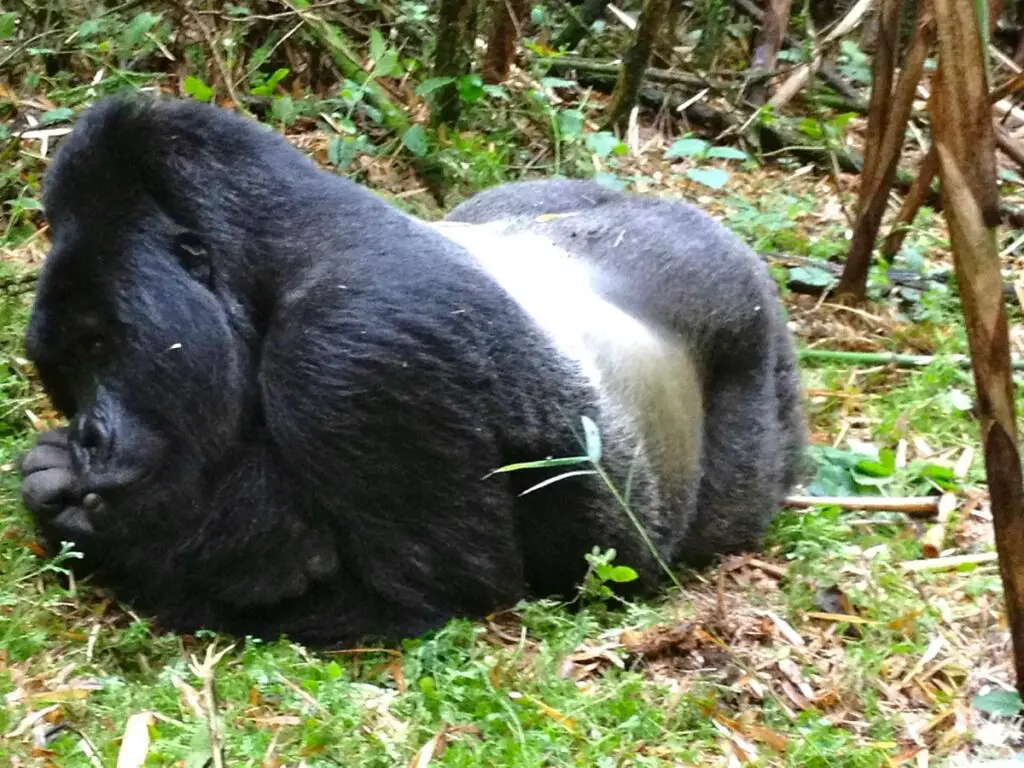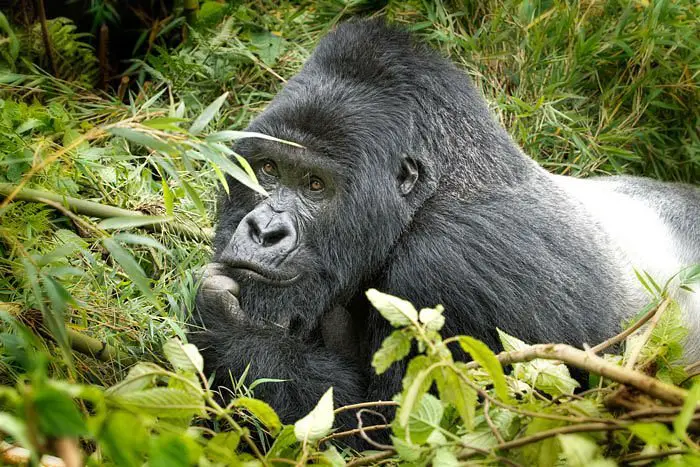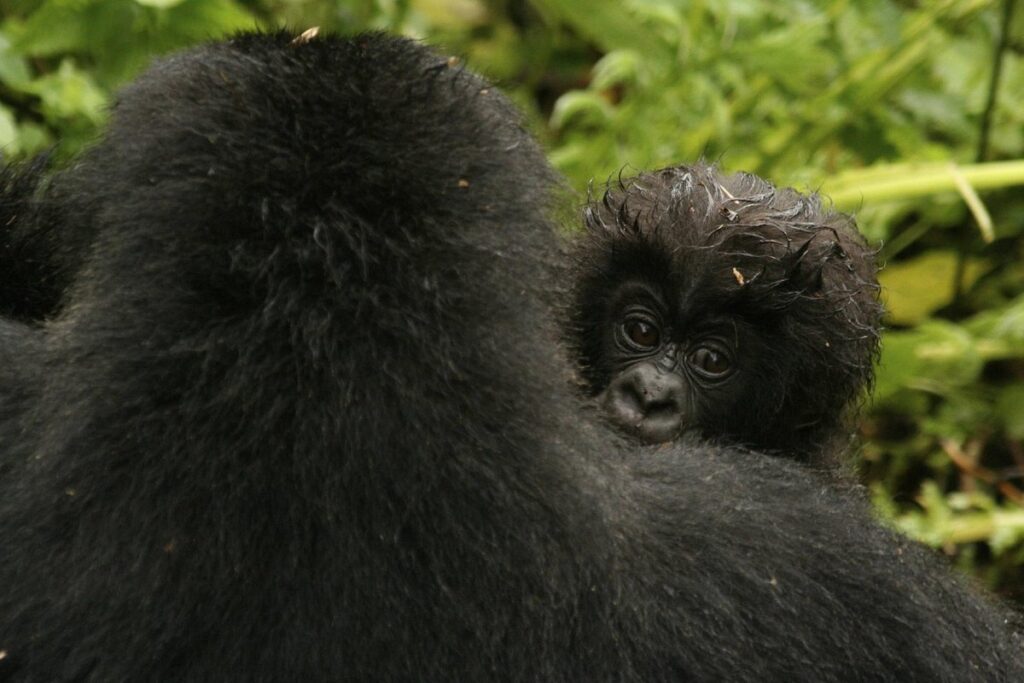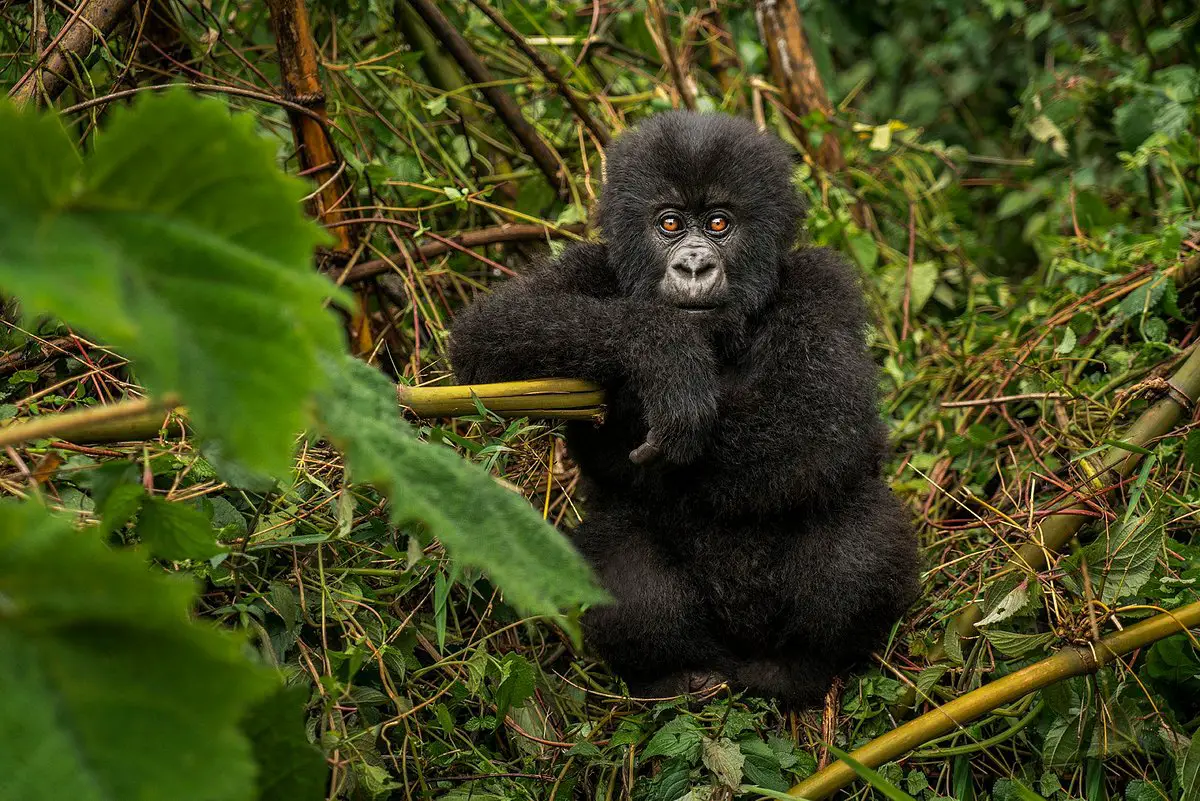Mountain gorillas are fascinating creatures known for their impressive size, expressive faces, and gentle demeanour. However, they are also among the most endangered species in the world. In this article, we’ll explore ten intriguing facts about these remarkable primates.
Live in just two places in the world
Mountain gorillas, one of the two subspecies of the eastern gorilla, have a very specific and limited habitat range. They are found in only two regions in the world.
Virunga Massif: This area, also known as the Virunga Volcanoes, includes three national parks that spread across three countries: Virunga National Park in the Democratic Republic of Congo, Volcanoes National Park in Rwanda, and Mgahinga Gorilla National Park in Uganda. This area is a series of volcanic mountains, including eight major volcanoes. The region’s altitude ranges from 2,200–4,300 meters (7,200–14,100 feet), and the gorillas’ habitat includes various vegetation zones, from bamboo forests at lower elevations to alpine moorland at higher elevations.
Bwindi Impenetrable National Park: Located in Uganda, this national park is a UNESCO World Heritage site and is renowned for its biodiversity. It contains both lowland and montane forest, and it is accessible only on foot due to its challenging terrain. The altitude in Bwindi ranges from 1,160 to 2,607 meters (3,800–8,550 feet).
They are The Largest Primates

Adult male mountain gorillas, or ‘Silverbacks’, typically weigh between 140 to 195 kg (310 to 430 lbs). Females, which are usually smaller, weigh between 90 to 100 kg (200 to 220 lbs). However, there are reported cases where some Silverbacks have reached weights up to 220 kg (484 lbs).
When standing on all fours, which is their usual stance, mountain gorillas are about 1.5 meters (4.9 feet) tall. However, when standing upright on two legs, a trait not often displayed, they can reach heights of up to 1.7 meters (5.6 feet). This standing height is much taller than other primates, such as the chimpanzee, which typically stand about 1.2 meters (4 feet) tall.
Despite being the largest primates, mountain gorillas are generally peaceful and shy creatures. The combination of their immense physical presence and gentle demeanor makes them one of the most fascinating species in the animal kingdom.
They Have A Unique Diet
The diet of mountain gorillas is quite unique and adapted to the environment they inhabit, characterized by its high-altitude and dense vegetation. Despite their formidable size and strength, mountain gorillas are predominantly herbivorous and rely on a variety of plant species for their dietary needs.
Mountain gorillas feed on over 100 different species of plants. Their diet primarily consists of leaves, shoots, and stems, which make up nearly 86% of their food intake. The remainder is filled with roots, bark, flowers, and some fruits. Contrary to popular belief, mountain gorillas eat relatively little fruit compared to other gorilla species, such as lowland gorillas, primarily due to the scarcity of fruit in their mountainous habitats.
Although mountain gorillas are mainly herbivores, they occasionally consume small animals and insects. Ants, termites, snails, and grubs can provide an extra protein boost. However, this kind of food represents a minimal portion of their diet.
They Have Complex Social Structures

Mountain gorillas have intricate social structures that dictate their interactions, roles, and behaviors within the group. These structures are hierarchical, with the dominant Silverback maintaining leadership and providing protection for the group.
Mountain gorilla groups, also known as troops, typically consist of one dominant Silverback (mature male), multiple females, and their offspring. However, some groups may have more than one Silverback, with the second being less dominant and often a younger brother, half-brother, or even an adult son of the dominant Silverback.
The dominant Silverback is usually the only male that mates with the females in the group. Females mature at around 10 years of age and typically have one offspring every four to six years after a gestation period of about 8.5 months.
Although typically peaceful, conflicts can arise within the group, usually around breeding rights. When two Silverbacks fight, it can be a violent clash of power, but it generally does not happen unless a group is invaded by an outside male or a dominant Silverback is challenged by a younger male from within the group.
They Have Unique Fingerprints
Much like humans, mountain gorillas have unique fingerprints. This means that the pattern of ridges and whorls on the fingertips of each gorilla is distinct and does not match any other individual’s patterns. This fact is especially fascinating considering the close genetic relationship between humans and gorillas, which share about 98.3% of their DNA.
The uniqueness of each gorilla’s fingerprints can be used by researchers and conservationists to identify individual gorillas in the wild. This is particularly useful in monitoring the behavior, health, and movement patterns of specific individuals, and tracking population changes over time.
The study of fingerprints, also known as dermatoglyphics, in gorillas and other primates, is of particular interest to researchers. It can provide insights into the evolution of these patterns and their purposes. Some research suggests these patterns improve grip and tactile sensitivity, critical for primates who climb trees and manipulate objects.
They Share DNA With Humans

It’s estimated that mountain gorillas share about 98.3% of their DNA with humans. This significant overlap means that of the three billion base pairs in the human genome, nearly all are identical to those of the mountain gorilla.
Humans and gorillas share a common ancestor, and it’s believed that the two species diverged from this common lineage around 9 million years ago. Since then, each species has undergone its unique evolutionary process, but the genetic similarity remains.
After bonobos and chimpanzees, gorillas are our closest living relatives in the primate family. Our shared DNA allows scientists to learn more about human evolution and physiology by studying these closely related species.
The similarity in DNA also means that gorillas and humans can be susceptible to some of the same diseases, especially those with a genetic basis. This includes heart disease, which is a leading cause of death in both humans and gorillas in captivity.
Mountain Gorillas are an Endangered Species
Mountain gorillas are classified as an endangered species by the International Union for Conservation of Nature (IUCN). This classification means that the species is considered to be facing a high risk of extinction in the wild. Below are several factors contributing to the endangerment of mountain gorillas:
One of the major threats facing mountain gorillas is the loss of their habitat. Expanding human populations lead to deforestation and fragmentation of forests for agriculture, settlement, and other uses. This reduces and splits the habitat of mountain gorillas, limiting their living space and resources.
Although it’s illegal, poaching still poses a significant threat to mountain gorillas. They are occasionally caught in snares intended for other animals, leading to injury or death. Moreover, despite legal protections, hunting for bushmeat and illegal pet trade also contributes to the decline of their population.
They Play A Key Role In The Ecosystem
Mountain gorillas play a critical role in maintaining the health and stability of the ecosystems they inhabit. As primarily herbivores, gorillas consume a lot of fruit when it’s available. The seeds from this fruit pass through their digestive system and are excreted in different locations. This seed dispersal contributes significantly to the health and diversity of the forest. Some plant species might even rely on this process to help their seeds germinate.
By feeding on vegetation and excreting waste, gorillas play a crucial role in nutrient cycling. They help return nutrients to the soil, which in turn promotes plant growth.
Gorillas feed on a variety of plant species, and by doing so, they control the vegetation and help maintain the balance of the ecosystem. Their feeding habits can prevent certain plant species from dominating and allow others to thrive.
The feeding behavior of gorillas can also create habitats for other species. For instance, by breaking and pulling down vegetation while foraging, they can create light gaps in the forest canopy. These gaps allow sunlight to reach the forest floor, which promotes the growth of diverse understory vegetation and provides habitats for a wide variety of species.
Unique Lifespan and Reproduction

Mountain gorillas can live up to 40 to 50 years in the wild. Females tend to live slightly longer than males, owing to the hazards and physical demands associated with the male’s role as the group’s protector. The lifespan of gorillas in captivity can be longer, with some recorded to live into their 50s and even early 60s due to controlled diet, absence of predators, and medical care.
Female mountain gorillas reach sexual maturity earlier than males. They typically experience their first estrous cycle around 6 years of age but usually don’t conceive until about 10 years old. Males, on the other hand, become sexually mature around 12 years old, but they generally don’t start breeding until they are fully grown and have achieved the Silverback status around the age of 15.
There’s no specific breeding season for mountain gorillas, and they can mate at any time of the year. The dominant Silverback usually has exclusive breeding rights to the females in the group. The gestation period for mountain gorillas is approximately 8.5 months, similar to humans.
Gorilla mothers typically give birth to one baby at a time (twins are extremely rare). Newborn gorillas are tiny, weighing about 4 pounds (1.8 kilograms), and are utterly dependent on their mothers for care. The infants ride on their mother’s back from the age of 4 months through the first two or three years of their lives.

